Chemical Regeneration of Thermally Conditioned Basalt Fibres
Abstract
:1. Introduction
2. Materials and Methods
2.1. Raw Materials
2.2. Fibre Heat Treatment
2.3. Fibre Chemical Treatment
2.4. Single Fibre Tensile Testing
2.5. Focussed Ion Beam (FIB) Milling and Fracture Toughness Test
2.6. Scanning Electron Microscopy (SEM)
3. Results and Discussion
4. Conclusions
Author Contributions
Funding
Conflicts of Interest
References
- Oliveux, G.; Dandy, L.O.; Leeke, G.A. Current Status of Recycling of Fibre Reinforced Polymers: Review of technologies, reuse and resulting properties. Prog. Mater. Sci. 2015, 72, 61–99. [Google Scholar] [CrossRef] [Green Version]
- Jenkins, P.G.; Yang, L.; Liggat, J.J.; Thomason, J.L. Investigation of the strength loss of glass fibre after thermal conditioning. J. Mater. Sci. 2015, 50, 1050–1057. [Google Scholar] [CrossRef] [Green Version]
- Singha, K. A Short Review on Basalt Fiber. Int. J. Text. Sci. 2012, 1, 19–28. [Google Scholar]
- Deák, T.; Czigány, T. Chemical Composition and Mechanical Properties of Basalt and Glass Fibers: A Comparison. Text. Res. J. 2016, 79, 645–651. [Google Scholar] [CrossRef]
- Fiore, V.; Scalici, T.; Di Bella, G.; Valenza, A. A review on basalt fibre and its composites. Compos. Part B Eng. 2015, 74, 74–94. [Google Scholar] [CrossRef]
- Militký, J.; Kovačič, V.; Rubnerová, J. Influence of thermal treatment on tensile failure of basalt fibers. Eng. Fract. Mech. 2002, 69, 1025–1033. [Google Scholar] [CrossRef]
- Förster, T.; Sommer, G.S.; Mäder, E.; Scheffler, C. Surface, interphase and tensile properties of unsized, sized and heat treated basalt fibres. IOP Conf. Ser. Mater. Sci. Eng. 2016, 139, 012019. [Google Scholar] [CrossRef]
- Jenkins, P.G.; Riopedre-Méndez, S.; Sáez-Rodríguez, E.; Yang, L.; James, L. Investigation of the Strength of Thermally Conditioned Basalt and E-Glass Fibres. In Proceedings of the 20th International Conference on Composite Materials, Copenhagen, Denmark, 19–24 July 2015; pp. 19–24. [Google Scholar]
- Bhat, T.; Fortomaris, D.; Kandare, E.; Mouritz, A.P. Properties of thermally recycled basalt fibres and basalt fibre composites. J. Mater. Sci. 2018, 53, 1933–1944. [Google Scholar] [CrossRef]
- Seghini, M.C.; Sarasini, F.; Tirillò, J. Influence of thermal conditioning on tensile behaviour of single basalt fibres. Compos. Part B Eng. 2018, 132, 77–86. [Google Scholar]
- Feih, S.; Boiocchi, E.; Mathys, G.; Mathys, Z.; Gibson, A.G.; Mouritz, A.P. Mechanical properties of thermally-treated and recycled glass fibres. Compos. Part B Eng. 2011, 42, 350–358. [Google Scholar] [CrossRef] [Green Version]
- Yang, L.; Thomason, J.L. The thermal behaviour of glass fibre investigated by thermomechanical analysis. J. Mater. Sci. 2013, 48, 5768–5775. [Google Scholar] [CrossRef]
- Thomason, J.L.; Kao, C.C.; Ure, J.; Yang, L. The strength of glass fibre reinforcement after exposure to elevated composite processing temperatures. J. Mater. Sci. 2013, 49, 153–162. [Google Scholar] [CrossRef]
- Lilli, M.; Rossi, E.; Tirillò, J.; Sarasini, F.; Di Fausto, L.; Valente, T.; González, C.; Fernández, A.; Lopes, C.S.; Moscatelli, R.; et al. Quantitative multi-scale characterization of single basalt fibres: Insights into strength loss mechanisms after thermal conditioning. Mater. Sci. Eng. A 2020, 139963. [Google Scholar] [CrossRef]
- Yang, L.; Sáez, E.R.; Nagel, U.; Thomason, J.L. Can thermally degraded glass fibre be regenerated for closed-loop recycling of thermosetting composites? Compos. Part A Appl. Sci. Manuf. 2015, 72, 167–174. [Google Scholar] [CrossRef] [Green Version]
- Thomason, J.L.; Nagel, U.; Yang, L.; Sáez, E. Regenerating the strength of thermally recycled glass fibres using hot sodium hydroxide. Compos. Part A Appl. Sci. Manuf. 2016, 87, 220–227. [Google Scholar] [CrossRef] [Green Version]
- Bashir, S.T.; Yang, L.; Anderson, R.; Tang, P.L.; Liggat, J.J.; Thomason, J.L. A simple chemical approach to regenerating the strength of thermally damaged glass fibre. Compos. Part A Appl. Sci. Manuf. 2017, 102, 76–87. [Google Scholar] [CrossRef] [Green Version]
- Thomason, J.L.; Yang, L.; Meier, R. The properties of glass fibres after conditioning at composite recycling temperatures. Compos. Part A Appl. Sci. Manuf. 2014, 61, 201–208. [Google Scholar] [CrossRef] [Green Version]
- Thomason, J.L.; Kao, C.C.; Nagel, U.; Yang, L. Recover: Regenerating the Strength of Glass Fibres Thermally Recycled From End-of-Life. In Proceedings of the 20th International Conference on Composite Materials, Copenhagen, Denmark, 19–24 July 2015; pp. 19–24. [Google Scholar]
- Spierings, G.A.C.M. Wet chemical etching of silicate glasses in hydrofluoric acid based solutions. J. Mater. Sci. 1993, 28, 6261–6273. [Google Scholar] [CrossRef]
- Kant, M.; Penumadu, D. Fracture behavior of individual carbon fibers in tension using nano-fabricated notches. Compos. Sci. Technol. 2013, 89, 83–88. [Google Scholar] [CrossRef]
- Morishita, K.; Ochiai, S.; Okuda, H.; Inshikawa, T.; Sato, M.; Inoue, T. Fracture toughness of a crystalline silicon carbide fiber (tyranno-SA3). J. Am. Ceram. Soc. 2006, 89, 2571–2576. [Google Scholar] [CrossRef]
- Feih, S.; Mouritz, A.P.; Case, S.W. Determining the mechanism controlling glass fibre strength loss during thermal recycling of waste composites. Compos. Part A Appl. Sci. Manuf. 2015, 76, 255–261. [Google Scholar] [CrossRef]
- ASTM. C 1557-03 Standard Test Method for Tensile Strength and Young’s Modulus of Fibers 1; American Society for Testing and Materials: West Conshohocken, PA, USA, 2013; Volume 3, pp. 1–10. [Google Scholar]
- Weibull, W. A statistical distribution function of wide applicability. J. Appl. Mech. 1951, 18, 293–297. [Google Scholar]
- Sullivan, J.D.; Lauzon, P.H. Experimental probability estimators for Weibull plots. J. Mater. Sci. Lett. 1986, 5, 1245–1247. [Google Scholar] [CrossRef]
- Jacob, A. Composites can be recycled. Reinf. Plast. 2011, 55, 45–46. [Google Scholar] [CrossRef]
- Kennerley, J. Recycling Fibres Recovered from Composite Materials Using a Fluidised Bed Process. Ph.D. Thesis, University of Nottingham, Nottingham, UK, 1998. [Google Scholar]
- Thomason, J.L. On the application of Weibull analysis to experimentally determined single fibre strength distributions. Compos. Sci. Technol. 2013, 77, 74–80. [Google Scholar] [CrossRef]
- Liu, J.; Jiang, M.; Wang, Y.; Wu, G.; Wu, Z. Tensile behaviors of ECR-glass and high strength glass fibers after NaOH treatment. Ceram. Int. 2013, 39, 9173–9178. [Google Scholar] [CrossRef]
- Wei, B.; Cao, H.; Song, S. Tensile behavior contrast of basalt and glass fibers after chemical treatment. Mater. Des. 2010, 31, 4244–4250. [Google Scholar] [CrossRef]
- Scheffler, C.; Förster, T.; Mäder, E.; Heinrich, G.; Hempel, S.; Mechtcherine, V. Aging of alkali-resistant glass and basalt fibers in alkaline solutions: Evaluation of the failure stress by Weibull distribution function. J. Non. Cryst. Solids 2009, 355, 2588–2595. [Google Scholar] [CrossRef]
- Ogihara, S.; Imafuku, Y.; Yamamoto, R.; Kogo, Y. Application of FIB technique to introduction of a notch into a carbon fiber for direct measurement of fracture toughness. J. Phys. Conf. Ser. 2009, 191, 012009. [Google Scholar] [CrossRef]
- Herraez, M.; Fernandez, A.; Lopes, C.S.; Gonzalez, C. Strength and toughness of structural fibres for composite material reinforcement. Philos. Trans. R. Soc. A Math. Phys. Eng. Sci. 2016, 374, 20150274. [Google Scholar] [CrossRef] [Green Version]
- Freiman, S.W.; Mecholsky, J.J. The Fracture of Brittle Materials; John Wiley & Sons, Inc.: Hoboken, NJ, USA, 2012; ISBN 9781118147757. [Google Scholar]
- Toribio, J.; Álvarez, N.; González, B.; Matos, J.C. A critical review of stress intensity factor solutions for surface cracks in round bars subjected to tension loading. Eng. Fail. Anal. 2009, 16, 794–809. [Google Scholar] [CrossRef]
- Jenkins, P.G. Understanding physical changes and strength loss of E-glass fibres following exposure to elevated temperatures. Mater. Sci. Technol. 2017, 33, 255–264. [Google Scholar] [CrossRef] [Green Version]
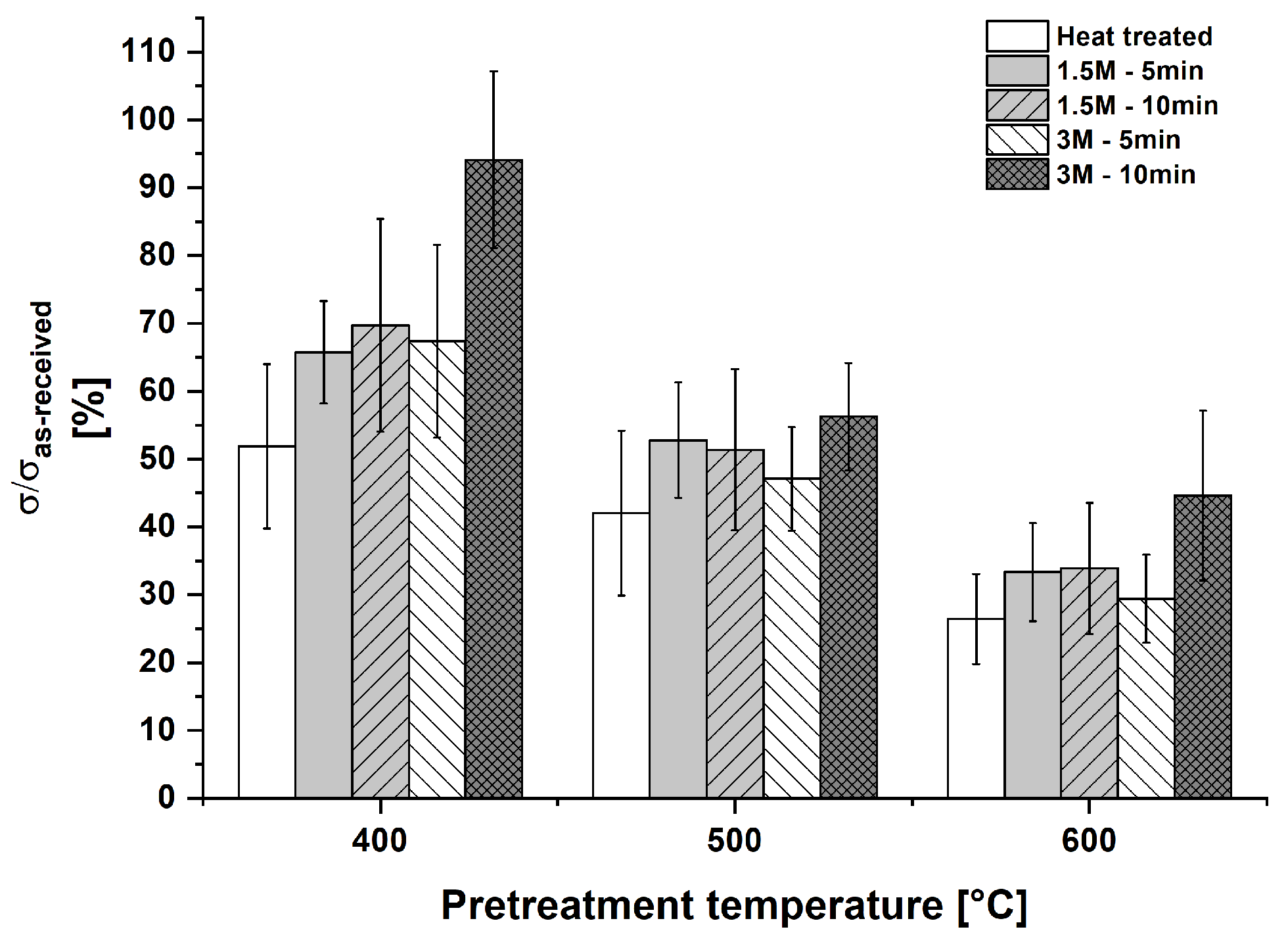
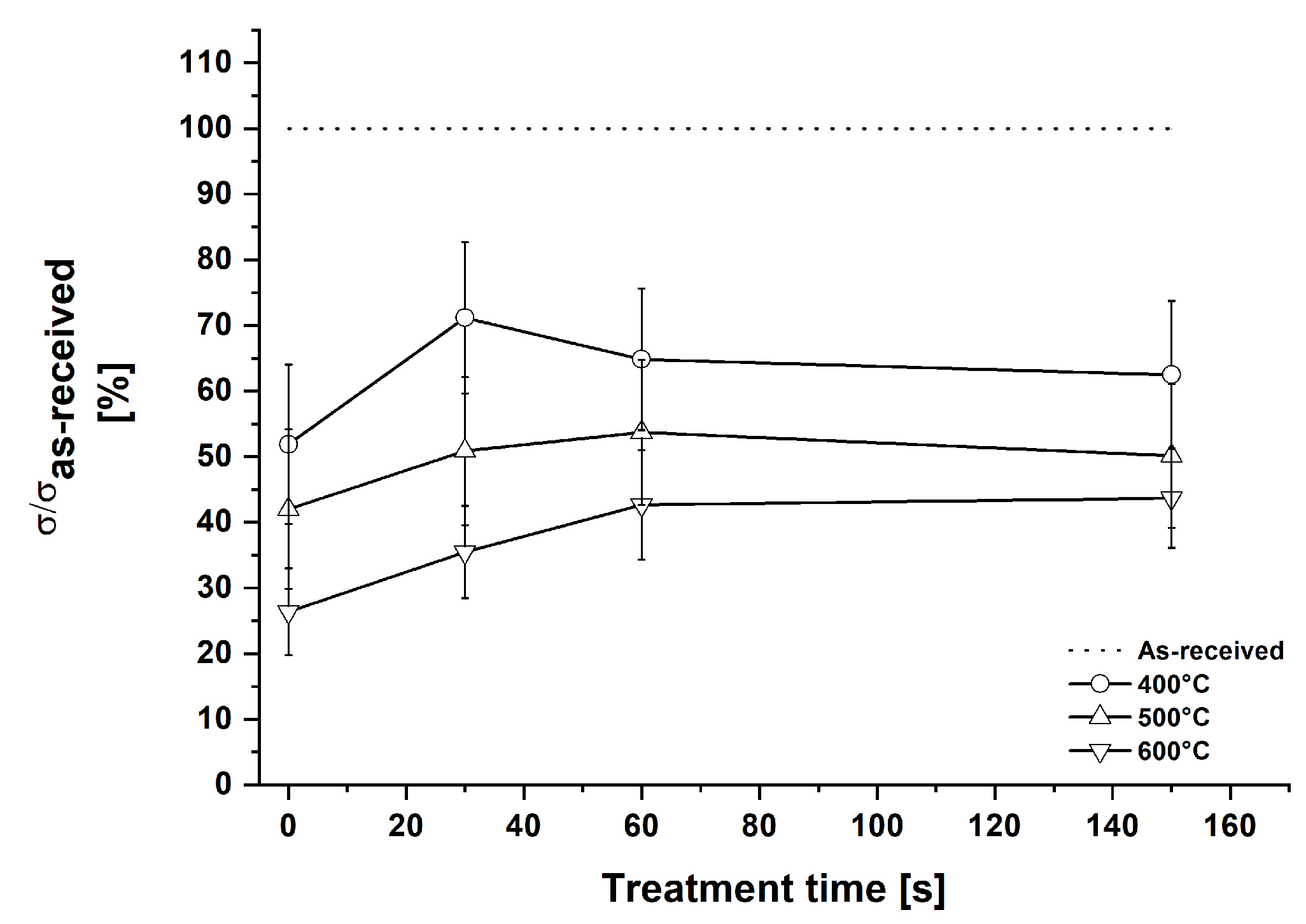

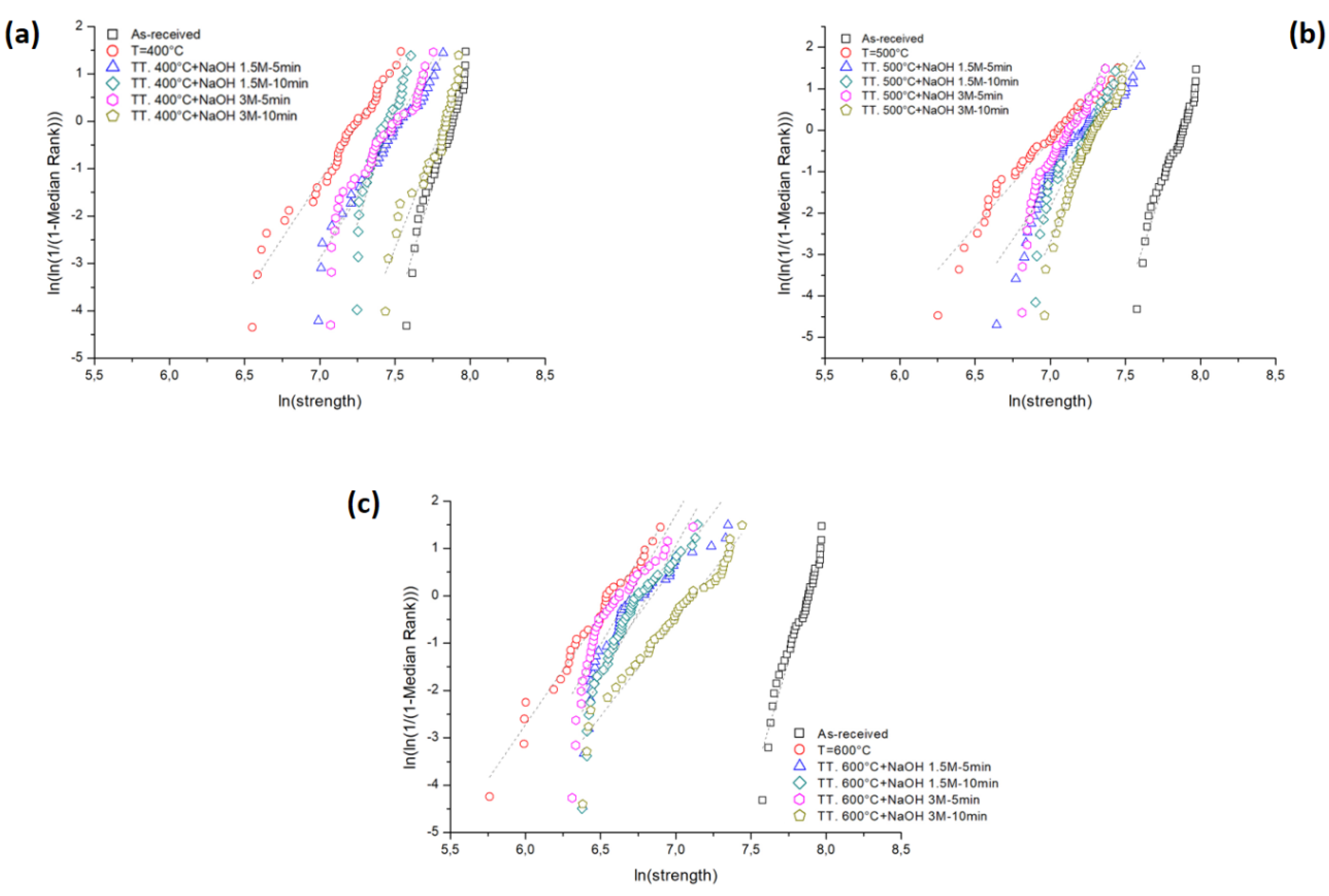
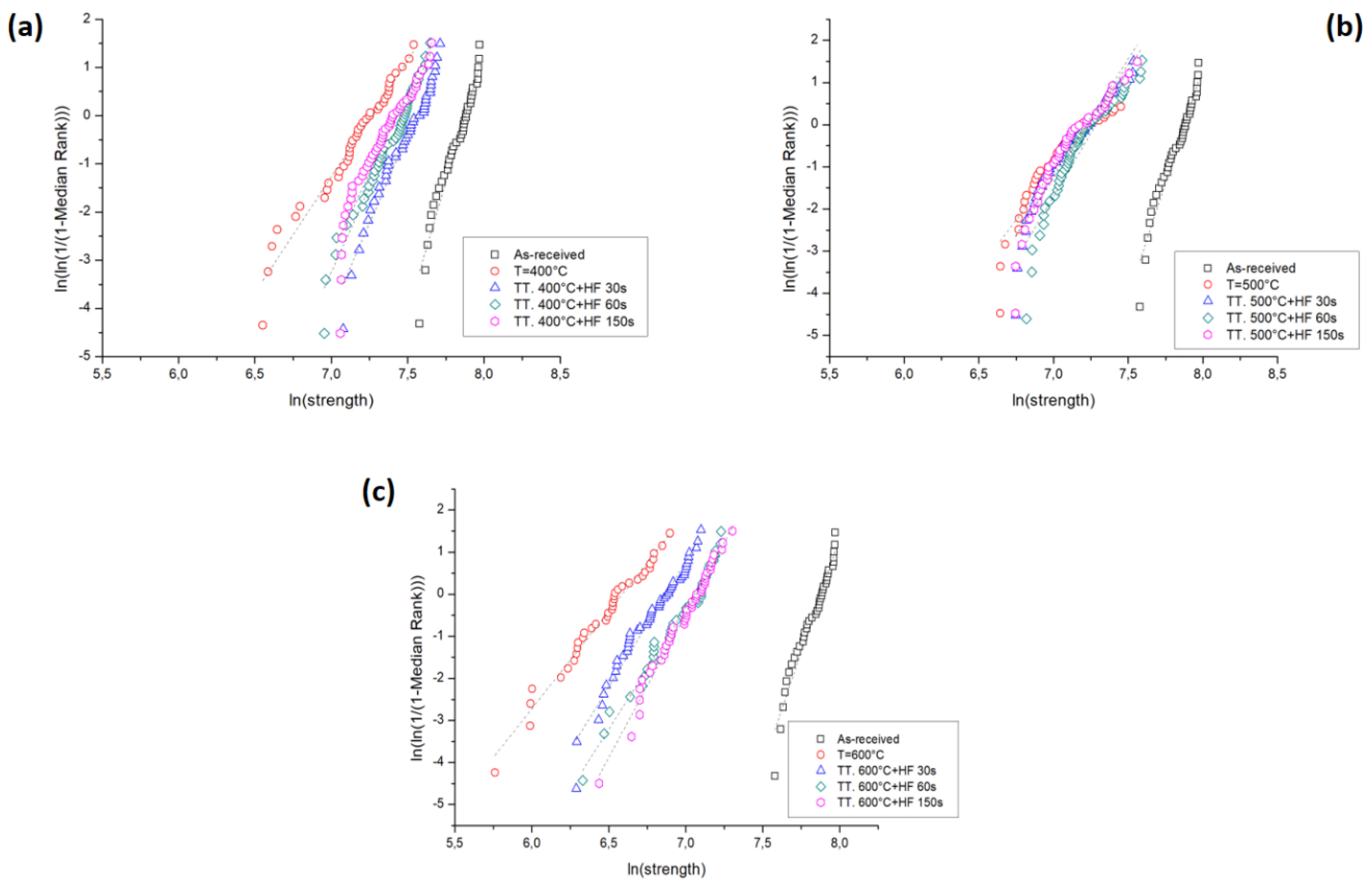
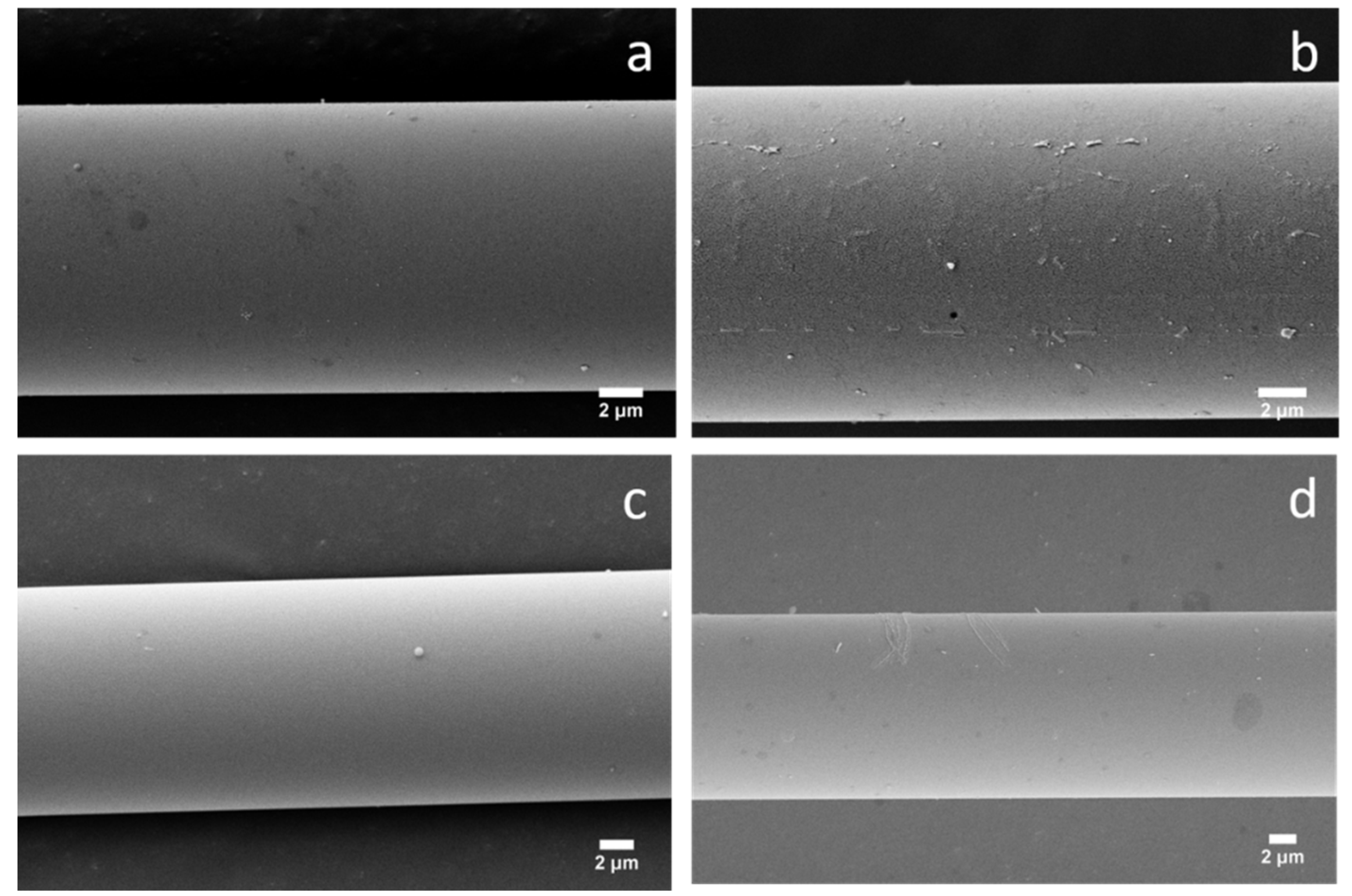
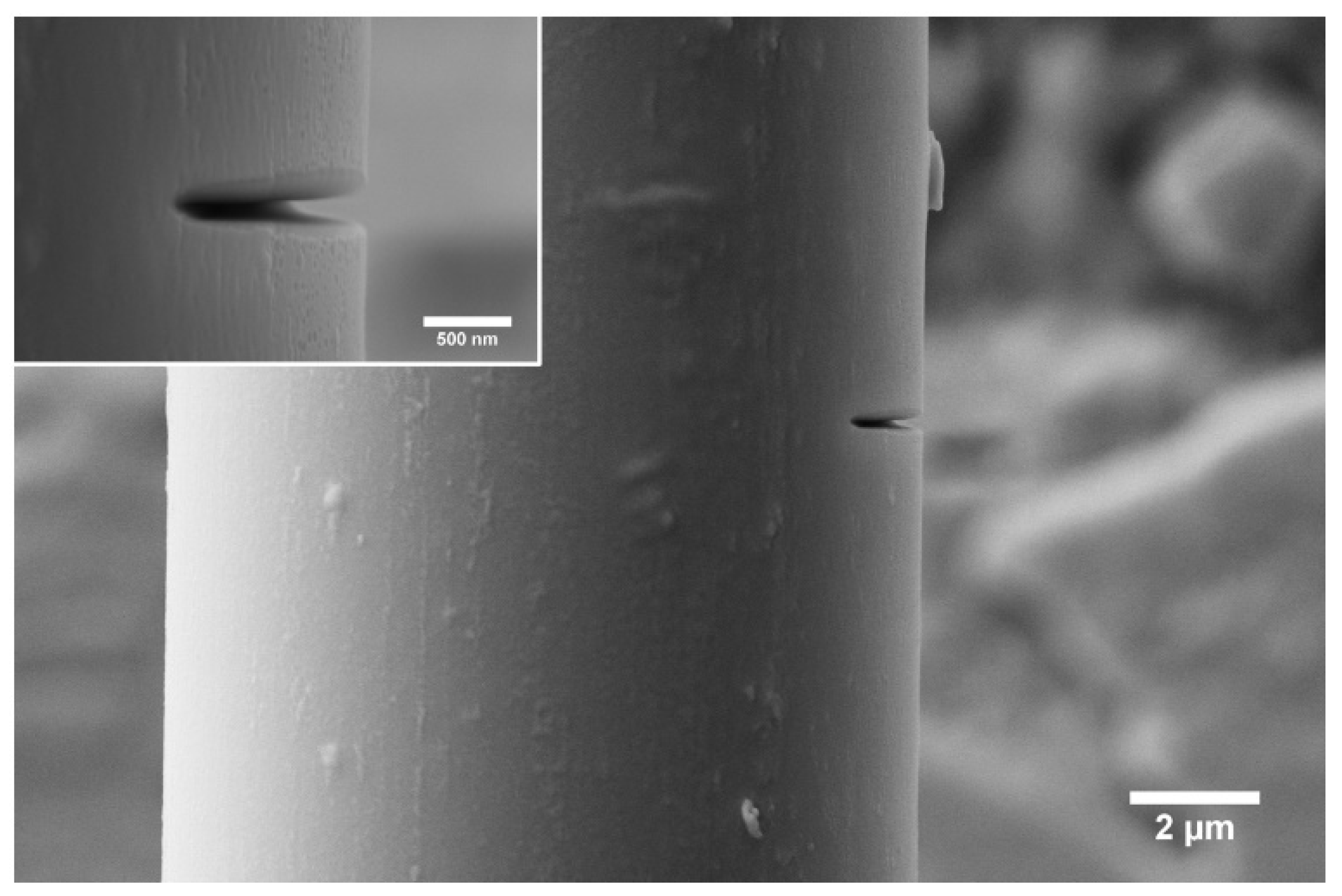
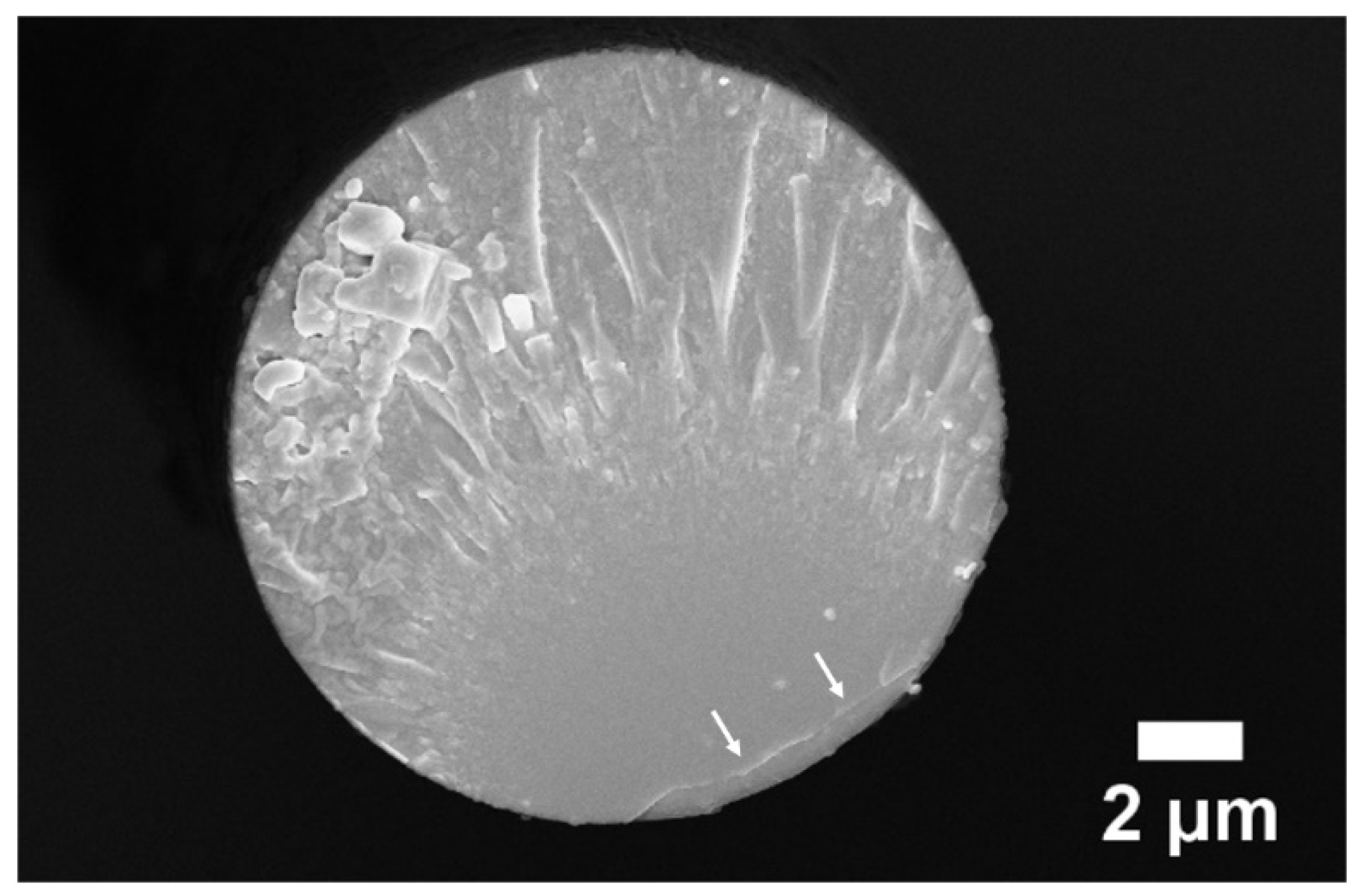
| Heat Treatment Temperature (°C) | Chemical Treatment with NaOH | Tensile Strength (MPa) | Weibull Modulus—ασ | Scale Parameter—σ0 (MPa) |
|---|---|---|---|---|
| R.T. | - | 2514.85 (276.67) | 10.85 | 2634.19 |
| 400 | - | 1304.77 (304.96) | 4.82 | 1425.17 |
| 1.5 M-5 min | 1753.98 (394.36) | 5.25 | 1905.02 | |
| 1.5 M-10 min | 1653.53 (189.30) | 10.24 | 1736.76 | |
| 3 M-5 min | 1694.83 (356.98) | 5.53 | 1837.44 | |
| 3 M-10 min | 2366.63 (327.84) | 8.16 | 2511.32 | |
| 500 | - | 1056.67 (305.80) | 4.16 | 1162.30 |
| 1.5 M-5 min | 1291.53 (299.30) | 5.31 | 1402.48 | |
| 1.5 M-10 min | 1327.48 (214.57) | 7.20 | 1417.86 | |
| 3 M-5 min | 1183.72 (192.49) | 7.33 | 1263.30 | |
| 3 M-10 min | 1414.40 (199.43) | 8.63 | 1496.41 | |
| 600 | - | 663.96 (166.22) | 4.63 | 726.29 |
| 1.5 M-5 min | 852.16 (242.65) | 4.34 | 939.16 | |
| 1.5 M-10 min | 838.42 (182.42) | 5.61 | 908.06 | |
| 3 M-5 min | 739.90 (163.08) | 5.48 | 803.56 | |
| 3 M-10 min | 1122.05 (315.50) | 4.10 | 1236.64 |
| Heat Treatment Temperature (°C) | Chemical Treatment with HF | Tensile Strength (MPa) | Weibull Modulus—ασ | Scale Parameter—σ0 (MPa) |
|---|---|---|---|---|
| R.T. | - | 2514.85 (276.67) | 10.85 | 2634.19 |
| 400 | - | 1304.77 (304.96) | 4.82 | 1425.17 |
| 30 s | 1789.97 (289.39) | 7.31 | 1909.11 | |
| 60 s | 1630.58 (271.17) | 7.01 | 1743.09 | |
| 150 s | 1571.87 (281.29) | 6.66 | 1685.90 | |
| 500 | - | 1056.67 (305.80) | 4.16 | 1162.30 |
| 30 s | 1279.32 (283.81) | 5.43 | 1387.58 | |
| 60 s | 1351.33 (278.03) | 5.97 | 1457.70 | |
| 150 s | 1260.74 (276.38) | 5.55 | 1365.60 | |
| 600 | - | 663.96 (166.22) | 4.63 | 726.29 |
| 30 s | 892.49 (177.62) | 5.96 | 962.34 | |
| 60 s | 1073.20 (209.79) | 5.77 | 1159.87 | |
| 150 s | 1098.44 (189.66) | 6.81 | 1175.79 |
| Temperature (°C) | Chemical Treatment | a/D | SIF—Y | Residual Strength (MPa) | Fracture Toughness (MPa√m) | Reference |
|---|---|---|---|---|---|---|
| R.T. | - | 0.15 (0.06) | 1.28 (0.16) | 420.85 (195.93) | 1.17 (0.45) | [14] |
| 600 | - | 0.13 (0.05) | 1.30 (0.17) | 569.88 (168.08) | 1.62 (0.46) | [14] |
| 600 | NaOH 1.5 M 5 min | 0.10 (0.04) | 1.26 (0.03) | 893.86 (166.26) | 2.14 (0.57) | This study |
| 600 | NaOH 3 M 10 min | 0.13 (0.04) | 1.24 (0.02) | 984.89 (295.63) | 2.53 (0.59) | This study |
| 600 | HF 1 v% 2.5 min | 0.16 (0.03) | 1.24 (0.02) | 991.16 (315.94) | 2.88 (0.53) | This study |
© 2020 by the authors. Licensee MDPI, Basel, Switzerland. This article is an open access article distributed under the terms and conditions of the Creative Commons Attribution (CC BY) license (http://creativecommons.org/licenses/by/4.0/).
Share and Cite
Lilli, M.; Sarasini, F.; Fausto, L.D.; González, C.; Fernández, A.; Lopes, C.S.; Tirillò, J. Chemical Regeneration of Thermally Conditioned Basalt Fibres. Appl. Sci. 2020, 10, 6674. https://doi.org/10.3390/app10196674
Lilli M, Sarasini F, Fausto LD, González C, Fernández A, Lopes CS, Tirillò J. Chemical Regeneration of Thermally Conditioned Basalt Fibres. Applied Sciences. 2020; 10(19):6674. https://doi.org/10.3390/app10196674
Chicago/Turabian StyleLilli, Matteo, Fabrizio Sarasini, Lorenzo Di Fausto, Carlos González, Andrea Fernández, Cláudio Saúl Lopes, and Jacopo Tirillò. 2020. "Chemical Regeneration of Thermally Conditioned Basalt Fibres" Applied Sciences 10, no. 19: 6674. https://doi.org/10.3390/app10196674






